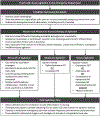Pharmacologic Management of Acute Agitation in Youth in the Emergency Department
- PMID: 34397677
- PMCID: PMC8383287
- DOI: 10.1097/PEC.0000000000002510
Pharmacologic Management of Acute Agitation in Youth in the Emergency Department
Abstract
When youth in the emergency department become acutely agitated, it can be dangerous and distressing to patients, families, and clinicians. Timely, effective, and patient-centered management is key to reducing the potential for patient and staff injury while preserving patient dignity. We review the definition of agitation and pharmacologic management for youth with acute agitation, including common classes of medications, indications for use, and adverse effects. We also discuss the need to integrate the use of medications into a comprehensive strategy for agitation management that begins with proactive prevention of aggressive behavior, creation of a therapeutic treatment environment, and verbal de-escalation strategies.
Copyright © 2021 Wolters Kluwer Health, Inc. All rights reserved.
Conflict of interest statement
Figures
References
-
- Gerson R, Malas N, Feuer V, et al.Best Practices for Evaluation and Treatment of Agitated Children and Adolescents (BETA) in the Emergency Department: Consensus Statement of the American Association for Emergency Psychiatry. West J Emerg Med. 2019;20(2):409–418. doi:10.5811/westjem.2019.1.41344 - DOI - PMC - PubMed
Publication types
MeSH terms
Grants and funding
LinkOut - more resources
Full Text Sources


